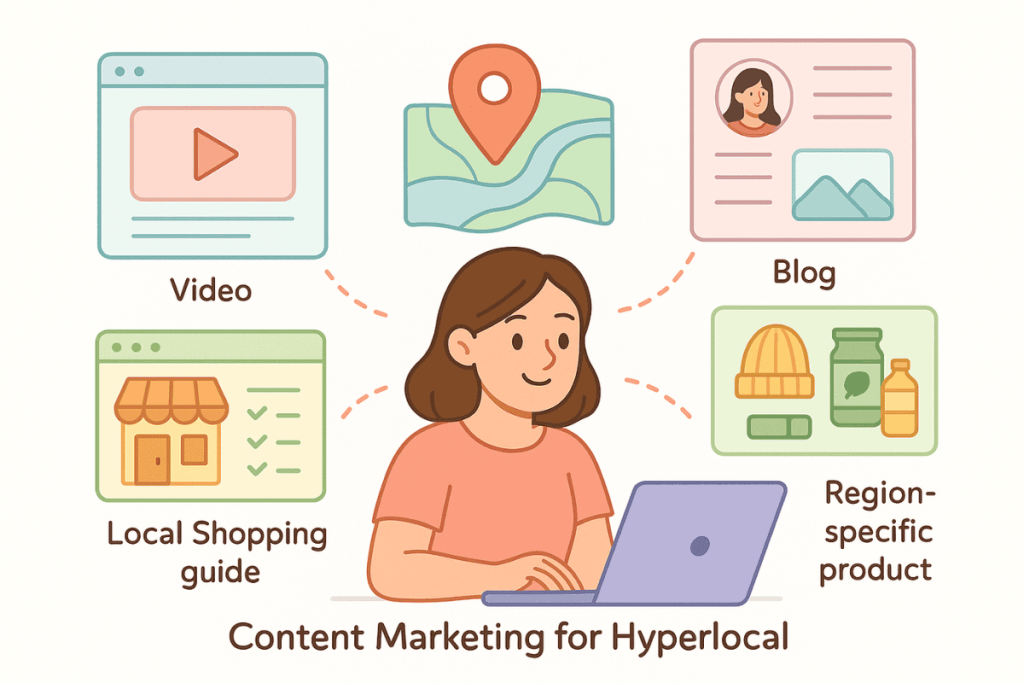
Hyperlocal marketing is one of the most practical strategies for connecting your WooCommerce marketplace with nearby buyers. It focuses on targeting people based on specific geographic areas, often down to the neighborhood level.
For vendors operating on a WooCommerce multi-vendor site, this approach helps capture local demand, stand out against broader competitors, and increase visibility in map-based and mobile searches.
It’s particularly effective for marketplaces that support local delivery, services, or in-person pickup—helping sellers tailor messaging and offerings to the communities they serve.
So, let’s get started!
What Is Hyperlocal Marketing?
Hyperlocal marketing refers to digital and offline efforts that target a narrowly defined location. Instead of advertising to an entire city or region, businesses focus on specific zip codes, neighborhoods, or even blocks.
This kind of targeting is especially relevant for local businesses and vendors on marketplaces that want to build awareness in their immediate surroundings.
Benefits Of Hyperlocal Marketing
When done right, hyperlocal marketing can:
- Drive higher engagement thanks to location-specific relevance
- Support stronger customer relationships in local communities
- Improve ROI by reducing wasted ad spend on irrelevant audiences

It’s an effective hyperlocal marketing strategy for vendors trying to grow their footprint without expanding their logistics.
This shows why hyperlocal marketing matters and why it’s so important for local business visibility.
Common Challenges Of Hyperlocal Marketing
Despite its benefits, there are a few obstacles to navigate:
- Vendor consistency: It can be difficult to maintain brand voice and campaign timing across multiple local vendors.
- Measuring performance: Some metrics—like foot traffic or local name recognition—are harder to track without third-party tools.
Still, these issues are manageable when your WooCommerce marketplace plugin offers the right configuration and tracking features. Choosing the right marketing platform can also help solve these limitations.
Smart Hyperlocal Marketing Strategies That Work
Hyperlocal marketing works best when tactics are clearly aligned with the customer’s location and behavior. Whether you’re running a vendor marketplace or a local business directory, knowing which strategies drive foot traffic, visibility, or regional orders is what matters.
Below are four practical approaches that form the core of a successful hyperlocal marketing strategy. Each one is designed to help vendors stand out to local customers and engage with their communities more effectively.
Hyperlocal SEO and Google Business Profile Optimization

Hyperlocal SEO is a key part of any hyperlocal marketing strategy. Start by optimizing each vendor’s store page with local keywords, service area names, and city-specific phrases.
You can also use Google Business Profiles to establish local visibility. Though marketplaces can’t claim profiles for every vendor, individual sellers can. This is where it’s important to optimize your Google Business listing to improve visibility in hyperlocal digital marketing.
Encourage vendors to use consistent NAP (name, address, phone) data, collect local reviews, and update their profiles with accurate hours and photos. This small effort pays off when it comes to appearing in local listings and improving search engine optimization.
Ultimately, this shows why hyperlocal marketing is important—and how a little effort into search visibility can drive big wins for local business vendors.
Bonus Tip: Vendors can use the StoreAgent AI Product Descriptions tool to generate localized product descriptions optimized for search. It’s a simple way to improve SEO and connect better with nearby customers.
Hyperlocal Social Media Marketing

Social media remains one of the most effective tools for driving location-based awareness. Vendors can Hyperlocal social media marketing remains one of the most effective tools for driving location-based awareness and increasing local customer engagement. Vendors can post geotagged content, use regional hashtags, and run local awareness ads to target nearby audiences precisely.
Here are a few practical ideas:
- Share behind-the-scenes videos at local markets or events
- Use local slang or landmarks in captions to build familiarity
- Partner with local creators or influencers for cross-promotion
This kind of social media engagement helps humanize vendors and build community loyalty that big-box competitors can’t replicate.
That’s why leveraging social media should be a core part of your hyperlocal digital marketing strategy. It directly supports social media engagement and builds a consistent presence across channels.
Running Hyperlocal Ads (Google & Social)

If you want to push beyond organic reach, hyperlocal ads can help. On platforms like Google Ads and Facebook, you can target audiences within specific radii of a vendor’s location.
Focus on:
- Product availability in that region
- Limited-time local deals
- Vendor pickup or delivery services
Moreover, you can increase efficiency by using automated discount rules and geotargeted promotions. WC Vendors simplifies this process with built-in tools to configure discount pricing strategies tailored to local audiences.
In short, these types of hyperlocal marketing campaigns work best when the messaging aligns with local shopping behavior and regional preferences. When done right, hyperlocal advertising can drive immediate action and long-term engagement.
Content Marketing for Hyperlocal Campaigns

Content marketing still plays a major role. Blog posts, videos, and vendor interviews help you build topical authority while also speaking to regional audiences.
Example content:
- Local shopping guides
- Vendor spotlights in a specific area
- Region-specific product roundups
These content pieces are ideal for sharing on vendor storefronts and external sites to drive traffic back to your WooCommerce marketplace.
Each of these hyperlocal marketing strategies supports vendors in reaching the right audience with relevant, location-driven messaging. Combined, they provide a clear framework for growing your marketplace through authentic local engagement.
How WC Vendors Enables Successful Hyperlocal Marketing

With WC Vendors, marketplace owners have tools to localize vendor experiences. You can:
- Assign vendors to regional categories or store locations
- Display vendor info with map-based listings
- Filter product searches by shipping zone or region
This supports hyperlocal marketing campaigns by making it easier for customers to find nearby sellers.
Additionally, WC Vendors is built on WooCommerce so you get full control over checkout, shipping, and tax rules, which are essential for localized marketing. See how this works in a B2C marketplace setting where local buying behavior is key.
Conclusion
Hyperlocal marketing is more than just a buzzword. It’s a practical strategy that helps your WooCommerce marketplace support local vendors, drive community sales, and personalize marketing based on geography.
To recap, here’s what you need to succeed:
- Hyperlocal SEO and Google Business Profile Optimization
- Hyperlocal Social Media Marketing
- Running Hyperlocal Ads (Google & Social)
- Content Marketing for Hyperlocal Campaigns
With the right platform and a strong local strategy, your WooCommerce marketplace can serve regional audiences and stand out in niche markets.
Ready to make hyperlocal work for your marketplace? Explore our plans and features or try everything for yourself on the WC Vendors demo site.
